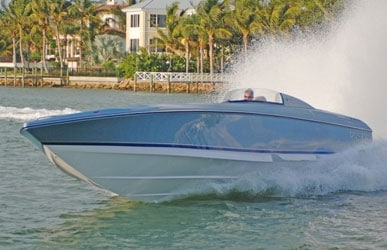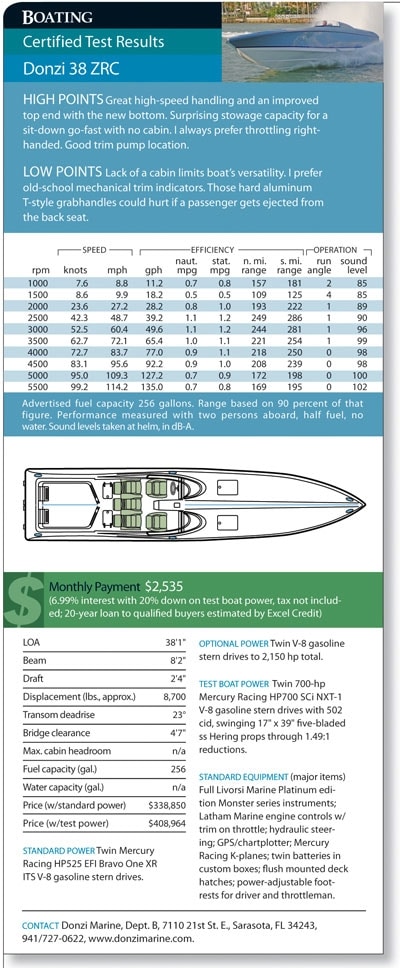
Donzi 38 ZRC

Donzi 38 ZRC Specs
Boatbuilders and designers of stepped hulls walk a fine line between getting the most speed out of a boat and making it manageable at high speed. Donzi got it right with the latest incarnation of its 38 ZRC.
The 38 ZRC first debuted five years ago as a twin-stepped model. In 2007, the manufacturer redesigned the bottom by adding shorter steps to further break adhesion to the water, which improved efficiency. With a pair of 700-hp Mercury Racing HP700 SCi NXT-1 packages, the boat ran 114 mph in windy conditions. In midrange acceleration tests, the boat ripped from 60 to 80 mph in 7.6 seconds and from 70 to 90 mph in 8.6 seconds.
The first step is 2½” tall and starts right under the quarter F-16 canopies, at about the 17′ mark. Abaft 2’11” is a ½” step followed by another taller step that’s 3′ aft. The final ½” step is 3’8″ farther back. Lifting strakes set close to the V in the forward section of the running surface help get the boat on plane quickly. Once the 38 ZRC is up and running, it rides on a keelpad with a shallow V. An 8″-tall transom notch spans between the outer strakes.
In washing machine-like conditions, the 38 ZRC has a reassuring feel. The boat carves smoothly through circles at 75 mph and zigs and zags through slalom turns up to 60 mph. Even at 100 mph the boat responded well to evasive maneuvers.
When you get in big water, you’ll appreciate the 38 ZRC’s heavy-duty construction. The bottom has a 1¼”-thick composite core with extra stiffening in the sides and deck. Stringers are composite cored forward of the engine compartment, and those beneath the motors are cored with marine plywood. The hull-to-deck joint is sealed with a methacrylate adhesive and bonded around the inside perimeter with fiberglass.
Take a Seat
I always feel more connected to the boat when I sit down to drive, whether I’m racing or pleasure zooming. It was no different aboard the 38 ZRC, which has five high-backed buckets. I liked that the boat is set up with port or starboard helms. I prefer driving on the port side, which frees up my right hand to throttle. Or you can move the helm to starboard if a friend wants to drive. I felt the throttles were too far away from the port seat. Donzi agreed and said it will move them about 2″ closer, which should work fine. Check it out when you sit at the helm.
Livorsi Monster Series instruments are laid out with the most important gauges ahead of the port bolster. The list includes the SmartCraft monitor flanked by tachometers. There’s an Azimuth compass tucked under the quarter canopy. The deck beneath each canopy is finished in black to kill glare.
Still to port, the engine monitoring gauges back up the SmartCraft equipment and are grouped by motor. There were no mechanical trim indicators for the drives or tabs on my boat because they were included in the optional SmartCraft SC 5000 screens ($2,964), something that will probably meet with mixed reviews because they’re hard to see in direct sunlight.
Forward of the centrally mounted controls, the Garmin 2206 GPSmap is visible from either front seat. The trim buttons are just below so that you can reach them with your throttling arm. There’s also a second set of buttons ahead alongside the starboard steering wheel hub if the driver wants to help set the boat’s attitude.
Cockpit stowage is provided in gunwale trays and in the bases of the back seats in compartmentalized lockers. I prefer this to one continuous box because it lets you better organize contents. You don’t need to stow a long item like a paddle on a 38′ go-fast. There are also large lockers between the aft seats and the engine compartment that are insulated so you can use them for coolers.
To help backseat passengers secure themselves, there are T-style aluminum grabhandles in the armrests. I prefer the softer loops found in the OuterLimits 39 GTX, which retails for $676,000 with the same test power and runs about 118 mph. Also with the 700-hp Mercs, the Fountain 42 Poker Run Edition sports a sticker of $496,060 and runs an estimated 118 mph. Its cockpit is a four-seater with grabhandles on the gunwales.
Your wife won’t like that the tops of the 38 ZRC’s engine hatches aren’t padded, but you’ll appreciate their lightness because you open them manually. With the hatches up, you have an easy step into the compartment onto the starboard outboard stringer. Stainless Marine sea strainers and Livorsi aluminum battery boxes are in good reach as are all the trim pumps on the compartment bulkhead. Normally, I’d gripe about the battery switch being under the hatch, but it’s a manual hatch, so a dead battery won’t prevent it from opening.
Vertically installed aluminum L-angles provide a solid foundation for the motors and you can get between the engines without a problem. About the only thing I saw that could use improvement was that some of the limber holes had a rough finish and could chafe hoses and wires. This was Hull No. 1 and Donzi said that won’t be the case on future models, but check it out. What will always be the case with the 38 ZRC is that it can post the big speed numbers and remain drivable.
Extra Point: Quarter canopies create a wind rush between them that beats up middle backseat passengers. Donzi solved this with a 3″ tall acrylic piece that bridges the gap.









